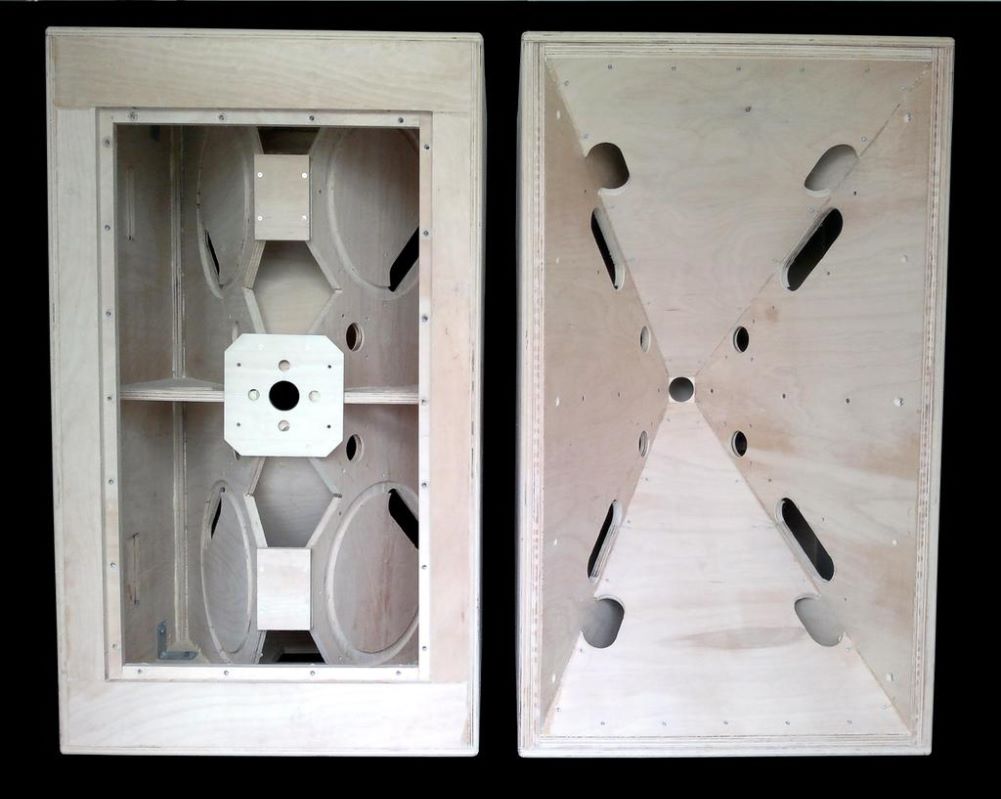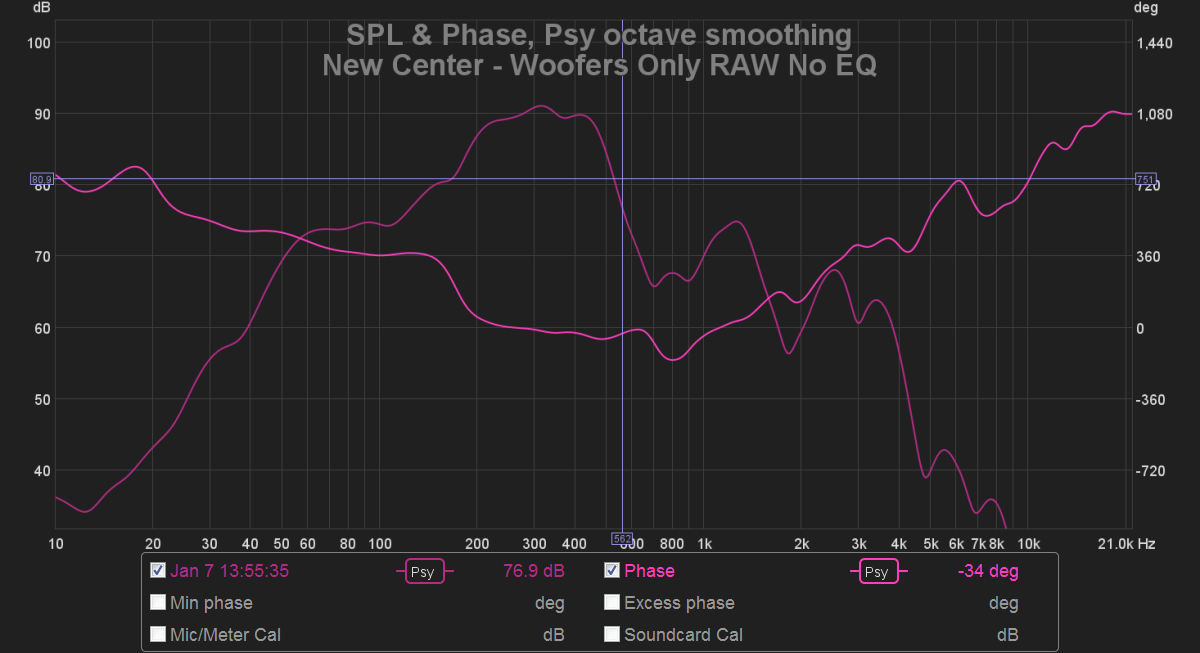-
Posts
2895 -
Joined
-
Last visited
-
Days Won
5
Content Type
Forums
Events
Gallery
Posts posted by NBPK402
-
-
How did you setup your k402s...do you aim directly at the MLP, before MLP, or after mlp?
Sent from my SM-T830 using Tapatalk
-
I actually like the more raw vocals sound better...maybe down the road I will like to try a more polished vocals, but for now no. I will have to see if I can dig up my old rew mlp settings for the JBLs to see how they were different with Dirac.
Sent from my SM-T830 using Tapatalk-
 1
1
-
-
I am loving the MEHs so much, and I am glad I decided to try them out! I used to have the JBL 2360As with the same horn drivers, and Q Pies, they def do not sound the same. On some songs I get a more raw sound that makes the singer sound like they are in the room. With the JBLs the sound of vocals were more of a polished, warmer sound. The bottom end on the MEHs is a fuller sound and appears to be digging a little deeper too. I have moved the speakers as far in the corners as I can, and I think the bass is even better than when we measured. I am still listening to see if there is any fine tuning that needs to be done other than placement and acoustic panels. Currently the soundstage is wide and some instruments sound like they are right next to me...12' from the rack in front of me. Absolutely awesome sounding.
I am wondering if my results might have something to do with the different size ports that we made because we were kr8g8nally goimg to go OB with them...which btw is also a great sounding way to go. Theis even more,spacios, but did not dig down as low,, so I had cabinets made.
Sent from my SM-T830 using Tapatalk
-
 2
2
-
 1
1
-
-
If you have not ever heard a pair of [mention=62555]Chris[/mention] A MEHs... I seriously suggest you do! I am very impressed with how mine turned out, and there is no way I could buy anything that would sound as good as these are for anywhere near what I have invested. Look for a used pair of k402s, and save some money too. I went the budget route and got EV DH1As, and then a new pair of Emminence kappa 15Cs...DH1As go for about $100 each used. They are not that hard to build either.
Sent from my SM-T830 using Tapatalk
-
 2
2
-
-
I have the center channel completed, and installed on its new angled stand, and my left and right channes are setup now in their positions.@Chris A do you want to work on the tune now or do you want to wait until I get the wood versions built?
Sent from my SM-T830 using Tapatalk -
Thanks Chris. I was wondering because I am putting together a wood/MDF horn that is modeled off the short side of the k402 and will be square. I intend for this to be a surround version that will be smaller, and was not sure if I should go with 2 15" woofers or 2 or 4 smaller woofers with the cabinet being almost half the size. I did not want to have to change the ports to change to a different size woofer, after the horn was setup for 15" woofers. Any recommendations on woofers for a 25" x 25" horn?This is not an easy answer for me to give you first-hand experience in context of MEHs. I would have to build a succession of MEHs having varying compression ratios (which I have historically defined as the ratio of the driver's diameter to the port's diameter--which is not area). This would costly, time-consuming, and difficult to sit and listen to the trade-off in subjective listening performance without introducing other unwanted factors into the listening trials.
Changing that ratio (i.e., making the off-axis ports either smaller or larger) has competing tradeoffs:- On one hand, it increases the efficiency of the woofers as the woofer off-axis ports get larger.
- On on the other hand, the off-axis polar coverage of the horn suffers in the region around the first bounce frequency of the off-axis ports relative to the apex compression driver port (the "first notch frequency"). There is a dropout in off-axis horizontal polar coverage around 400-500 Hz as the off-axis port area increases (as a function of the total sidewall area on the horn where the off-axis ports are located). This turns out to be the most limiting factor in my experience.
So the alternative is to lengthen the ports along the crease in the horn to increase the port area, but this has limitations, too. If the port length becomes significant relative to the highest wavelengths of sound that are produced by the woofers (i.e., 1/4 wavelength at 500 Hz is 6.8 inches), diffraction effects begin to show up at the highest woofer frequencies. So if the port length gets longer than 6.8 inches, you start to have issues with self-diffraction of the sound waves emitted at the highest woofer frequencies. (This is the same problem that driver phase plugs are there to fix.) It also begins to lower and deepen the first notch frequency of the woofers relative to the horn apex or throat.

The long ports on the larger sidewalls of this MEH are the off-axis woofer ports that have been elongated in order to increase their area for one-woofer/one-port operation
In summary, the answer is a bit complicated, and there are some other woofer interactions (loading the woofers at low frequencies vs. the exact horn shape and off-axis port locations) that turn out to be trade-offs that I haven't talked about yet. But in general, I believe that the relative compression ratios and T/S parameters of the woofers, the port placements, and their length/width ratio is proven by looking at what Danley has done. Unless you've got a lot of time and a fairly significant pile of money to build several horns of differing port areas/geometries, and use several different woofers having differing T/S parameters, the answer to your seemingly simple question shall largely remain obscure to generalizations on their effects.
You could try asking Tom Danley himself (whom I'm reasonably sure has done some of these trades), but I'm not sure that he would be willing to divulge the generalizations of what his company has found..."the hard way".
Chris
Sent from my SM-T830 using Tapatalk
-
 1
1
-
How does the compression ratio of the ports affect the sound...is it efficiency? What happens if you have less compression ratio vs higher compression ratio vs 10:1?
Sent from my SM-T830 using Tapatalk -
Just in case anyone is a veteran...you get a nice discount on Tidal.
Sent from my SM-G985F using Tapatalk -
Yes the i7 is windows 10... I also use it occasionally for Photoshop...hencewhy I was wondering if the i3 would be e ough on Manjaro Linux.Slightly confused. Is the i7 NUC the one with Win10? If so do you need it for anything else?
Ditch Win10 install ROCK on a M.2 SSD internal to the NUC and attach music files however you like (NAS, PC/Mac, external USB drive, etc.)
If I didn't need the NAS for movies/Plex my ideal Roon set up would be an i7 NUC, ROCK installed on internal M.2 SSD, identical 5TB USB drives. One connected to the NUC the other off site for backup. Small streamer like Pi/Lumin. A NOS DAC without volume control.....ie my Denafrips Venus II.[emoji6]
If not I will buy a other i7 NUC in the spring for Rock.
Sent from my SM-T830 using Tapatalk
-
I agree 100% with your comments, and I am glad you clarified. I am running Roon on win 10 (which I hate with a passion). I also have Linux Manjaro on a i3 NUC...would that be good enough for Roon? I use a ssd on a USB3 dongle(?),foer all my music and a MSATA Drive inside the NUC. I urr3 tlyplay music through Roon via my Yamaha cxa5100 via Music cast or directly to my tablet when I use headphones.
Sent from my SM-T830 using Tapatalk
-
Not meaning to argue, but doesn't the Lumin app run on a computer? Now if you mean a desktop computer, I can understand that is no longer needed since computers are much smaller now, and come in many forms..like tablets, and even cell phones.
Sent from my SM-T830 using Tapatalk-
 1
1
-
-
Roon requires a computer...I was under the impression that media players are basically a computer too. What is the difference besides price, and shielding for noise? I run a i7 NUC for Roon which is still a computer.In this day and age of quality streaming devices and network attached storage devices there is absolutely no reason to have a computer in the mix (unless you count the NAS).For me it’s Quobuz (sometimes Tidal) to my Lumin U1 mini to my MHDT DAC. I also have flac files on a Synology NAS, so it’s about 50/50 between streaming from the internet and playing local music.
Shakey
Sent from my SM-T830 using Tapatalk
-
 1
1
-
-
Looks great! I currently have my center sitting on a furniture dolly until I make a stand for it so I can angle it up to the mlp.I finally completed my room. Sounds fantastic, truly not heard a better HT or 2 channel.
My MEH works very well, I am 100% happy.
Sent from my SM-T830 using Tapatalk
-
I was listening to music when I heard the thud...it was not a loud thud as I was listening at 90db or less.
This is what I found... I am not driving the speakers hard at all. I am just worried that when I install the woofers there is only a fingernail of clearance and that leaves me almost zero clearance. With such a small amount of clearance it would not take much for them to hit. I have read where others have installed woofer rings with these woofers, and also some that have not. I want to be sure that when these ara fully tuned, I will not have any problems. As far as the thud I only know it is coming from the woofers. If I push on the woofer they do have some movement, but I have no idea how much they are moving when I hear the thud sound. If I stick my finger in the port the woofer is hardly moving at all.

Sent from my SM-T830 using Tapatalk
-
I looked at the specs for my Kappa 15c woofers and saw that they can move almost 1/2" at the lower frequencies. I have noticed sometimes a thud sound, so I have wondered for a while if they might be hitting since when I i stall them the gasket compresses to where there is about a finger nail gap between the mounting board and the basket. I am going to use some 12mm mdf for rings and install them on the center channel to see if the thud sound still happens. Now this thud is not when listening loud at all...it is when l8stening at -40 to -50 on my Yamaha which when using my phone spl meter is below 90db(midrange and above reading).
Are the 1/2" woofer rings going to affect anything besides the delays?
Sent from my SM-T830 using Tapatalk -
I got roon a couple of months ago, and I love it!
Sent from my SM-T830 using Tapatalk
-
Just trying to figure out if I should stick with the Kappas for the surrounds. The next pair will be made out of bendable plywood and mdf...modeled off of the short side of the k402. This will allow for a 25" square cabinet for use as surrounds. They will be smaller than a LaScala. If I am successful I will send all the info to you for suggestions for woofer size and port size. I am not sure if a 25x25x18 cabinet is big enough volume waize for 2 15s...maybe I need 4 10s?I've not used Kappa 15Cs (rather I'm using Crites 15" cast frame woofers), so I don't know the answer. I suppose I could guess but I don't think that would give you any real information.Chris
Sent from my SM-G985F using Tapatalk
-
Center channel cabinet arrived today, and it looks the best of the 3...proves that the more you do the better they come out! I will start assembly tomorrow, and then hopefully next weekend install it in the rack (I am waiting on the casters for the rack so I can install the center in place). Pics are of the center channel on its side.




Sent from my SM-T830 using Tapatalk-
 4
4
-
-
Do your woofers go lower than the Kappa15Cs?One of the capabilities that I use in my K-402-MEH is that it has such a good coupling with the room/boundaries (i.e., the horn mouth is not nearly as undersized like it is for other horn-loaded bass bins, and it therefore loads much better in boundary effect with its two 15" woofers), the F0 roll-off frequency of the K-402 itself in quarter space or eighth space (i.e., against a wall/floor interface in a room corner) is well below 200 Hz, especially due to better loading of the off-axis woofer ports away from the mouth of the K-402. (Something that is discussed in detail in Danley's Synergy Horn/tapped horn white paper. See figure 4 of that paper for an explanation).
The K-402-MEH actually couples to the room boundaries at and below the Schroeder frequency (~100 Hz in my listening room). This means that the K-402-MEH receives boundary gain loading to the woofers quite easily, which extends its in-room -3dB roll off frequency down to ~40-45 Hz, well below the frequency that would be predicted by horn length/horn expansion formulae.
Below you will see the raw response of the K-402-MEH along a wall (mid-wall, elevated about 3 feet above the floor):

After flattening out the rise in SPL response between 50 Hz and 700 Hz (a woofer SPL response characteristic of MEHs that is even more exaggerated by Danley Synergy of loudspeakers, such as the SH-50), and by adding a reasonable amount of EQ boost below F0, the K-402-MEH at mid-wall, it produces a -3 dB frequency at ~18 Hz (shown in the first post in this thread). That means it eliminates the need for a subwoofer in the center "anti-node" position of my listening room, without adding significant harmonic and modulation distortion to its output (in fact, lower distortion than the TH subwoofers on either side at the same higher SPLs).
This capability came as a total surprise when I was dialing it in using my Xilica crossover.
Chris
Sent from my SM-T830 using Tapatalk
-
Do a search online...there are sites you can up,oad your image to and then resize, and downooad again for freePic I’m trying to upload is 2.1 mb. Can’t seem to make it smaller on iPad.
Sent from my SM-T830 using Tapatalk
-
Is it an optical allusion or is the left channel sticking out more from the wall than the right?
Sent from my SM-T830 using Tapatalk -
Thank you! Now I know it will work out nicely. I should have my center by next week...just waiting on the casters to raise the rack up 6 more inches.
Sent from my SM-T830 using Tapatalk
-
I have a little dilemma... I was going to put the center k402 on top of my 29" tall rack (sideways), but then my 86" tv would have to go on top of it. The tv looks like it is at a perfect height on top of the rack. I think I can rearrange the equipment and put the k402 in the center angled upward... Has anyone any experience with the speaker being on the ground, and angled up toward the mlp vor the center? Our MLP is about 12' from the rack front.
Sent from my SM-T830 using Tapatalk
-
Please let me know how it goes... I will be ready to do mine after the first of the year, when I get my 2nd amp ready.Strange you should mention this, I was debating trying as a fun little project.
The crossovers are the same as 600M, circuit boards have been 600 and 160 stamped on them. I was considering performing the GR Research mods but instead of passive crossover build a miniDSP active.
Sent from my SM-T830 using Tapatalk
-
 1
1
-











Bob Crites has passed
in General Klipsch Info
Posted
Rip Bob.
Sent from my SM-T830 using Tapatalk